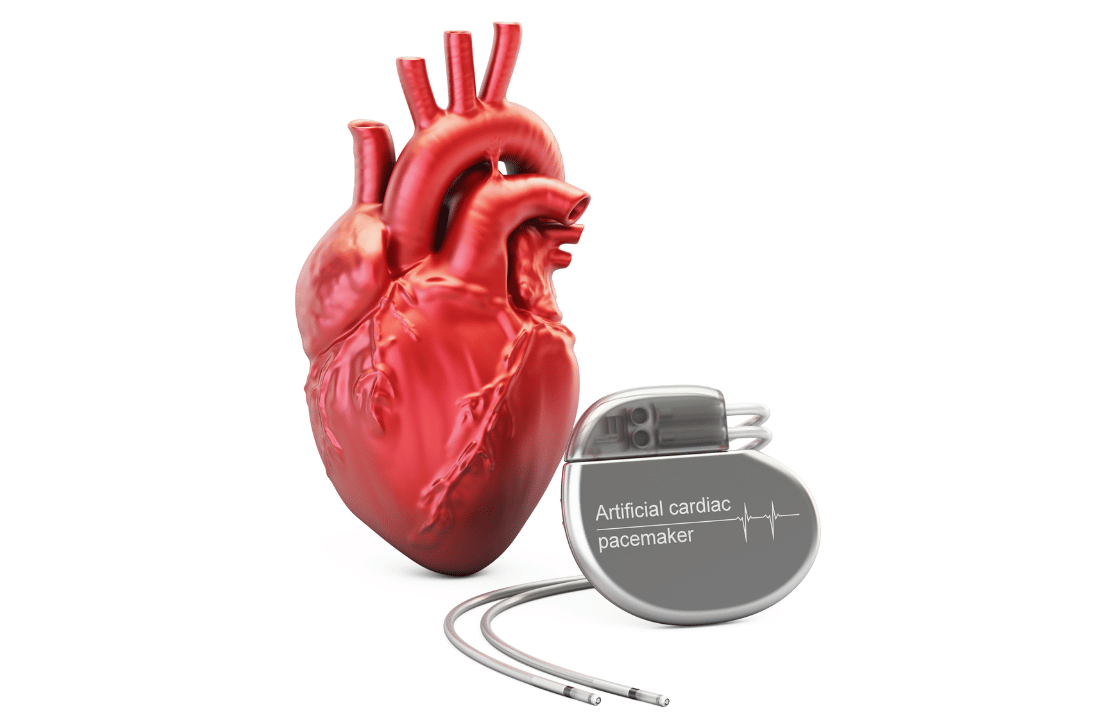Pacemaker Implantation
Home - Pacemaker Implantation

Pacemaker implantation is a common medical procedure used to treat arrhythmias, irregular heartbeats, and certain heart conditions that affect the heart’s electrical system. This procedure involves placing a small electronic device, called a pacemaker, under the skin near the collarbone to regulate the heart’s rhythm and ensure it beats at a steady rate.
Understanding Arrhythmias and Heart Conduction System
The heart’s electrical system controls the timing and coordination of heartbeats. In a healthy heart, an electrical signal starts in the sinoatrial (SA) node, the heart’s natural pacemaker, and travels through the atria and ventricles, causing them to contract and pump blood. Arrhythmias occur when there is a disruption in this electrical signalling, leading to irregular heartbeats.
Types of Arrhythmias
- Bradycardia: A slow heart rate (less than 60 beats per minute) due to problems with the SA node or the heart’s electrical pathways.
- Tachycardia: A fast heart rate (more than 100 beats per minute), often caused by the rapid firing of electrical impulses in the atria or ventricles.
- Atrial Fibrillation: Irregular, rapid heartbeat originating in the atria, affecting heart rhythm and blood flow.
Indications for Pacemaker Implantation
Pacemaker implantation may be recommended for patients who experience:
- Symptomatic Bradycardia: Including fatigue, dizziness, fainting (syncope), and shortness of breath due to a slow heart rate.
- Heart Block: Impaired conduction of electrical signals between the atria and ventricles, leading to delays or missed heartbeats.
- Atrial Fibrillation with Bradycardia: A combination of irregular heart rhythm and slow heart rate requiring pacing support.
Components of a Pacemaker
A pacemaker consists of several components:
- Pulse Generator: Contains the battery and electronic circuitry that generates electrical impulses to regulate heartbeats.
- Leads (Electrodes): Insulated wires that carry electrical impulses from the pulse generator to the heart chambers, typically placed in the right atrium and/or ventricle.
- Programming Device: Used by healthcare providers to adjust pacemaker settings and monitor heart activity during follow-up appointments.
Types of Pacemakers
Single-Chamber Pacemaker
A single-chamber pacemaker has one lead placed either in the right atrium or right ventricle to regulate the heartbeat in one chamber of the heart.
Dual-Chamber Pacemaker
A dual-chamber pacemaker has two leads, one in the right atrium and one in the right ventricle, allowing it to regulate the timing of electrical signals between the atria and ventricles for more synchronized heartbeats.
Biventricular (Cardiac Resynchronization Therapy) Pacemaker
Used for patients with heart failure and electrical dyssynchrony, a biventricular pacemaker has three leads: one in the right atrium, one in the right ventricle, and one in the left ventricle. This type of pacemaker coordinates the timing of contractions between the ventricles to improve heart function.
Pacemaker Implantation Procedure
Pre-Procedure Preparation
Before pacemaker implantation, you will undergo:
- Medical Evaluation: Including a physical exam, electrocardiogram (ECG), echocardiogram, and possibly a stress test to assess heart function and identify any underlying conditions.
- Discussion of Procedure: Your cardiologist will explain the purpose of pacemaker implantation, expected benefits, risks, and alternative treatment options.
Procedure Steps
- Anaesthesia: Local anaesthesia is administered to numb the area where the pacemaker will be implanted, usually near the left or right collarbone.
- Lead Placement: Your cardiologist makes a small incision to access a vein near the collarbone and guides the leads through the vein into the heart chambers using fluoroscopic imaging for guidance.
- Pulse Generator Placement: The pulse generator (pacemaker) is placed under the skin through a small incision near the collarbone and connected to the leads.
- Testing and Adjustment: Once the pacemaker is implanted, it is tested to ensure proper function and adjusted to deliver the appropriate electrical impulses to regulate heartbeats.
- Closure: The incision site is closed with sutures or adhesive strips, and a sterile dressing is applied.
Recovery and Hospital Stay
- Immediate Post-Procedure: You will be monitored in a recovery area to ensure stability and may stay overnight for observation, depending on your overall health and the complexity of the procedure.
- Follow-Up Care: Your cardiologist will schedule follow-up appointments to monitor pacemaker function, adjust settings if needed, and address any questions or concerns you may have.
Living with a Pacemaker
Living with a pacemaker involves:
- Activity Restrictions: Avoiding activities that may interfere with pacemaker function, such as intense physical contact sports or exposure to strong electromagnetic fields.
- Medication Adherence: Taking prescribed medications as directed to manage underlying heart conditions and support pacemaker function.
- Regular Follow-Up: Attending scheduled follow-up appointments with your cardiologist to monitor pacemaker performance, battery life, and overall heart health.
Conclusion
Pacemaker implantation is a safe and effective treatment for arrhythmias and heart conditions that disrupt the heart’s electrical system. Dr. Ankeet Dedhiya and our dedicated team of cardiologists and electrophysiologists are committed to delivering personalized care. We leverage cutting-edge technology to enhance heart function and improve the quality of life for patients in need of pacemaker therapy. Whether you are managing bradycardia, heart block, or other cardiac conditions, we are here to support you on your journey to optimal heart health.
FAQ
Frequently Asked Questions
A pacemaker is a small electronic device implanted near the collarbone to regulate the heart's rhythm by sending electrical impulses to ensure a steady heartbeat.
A pacemaker may be recommended for individuals experiencing symptomatic bradycardia (slow heart rate), heart block, or atrial fibrillation with bradycardia. These conditions can cause symptoms such as fatigue, dizziness, fainting, and shortness of breath.
There are several types of pacemakers:
- Single-Chamber Pacemaker: Uses one lead placed in either the right atrium or right ventricle.
- Dual-Chamber Pacemaker: Uses two leads, one in the right atrium and one in the right ventricle, to coordinate electrical signals between the atria and ventricles.
- Biventricular (Cardiac Resynchronization Therapy) Pacemaker: Uses three leads to coordinate contractions between the ventricles, often used in patients with heart failure and electrical dyssynchrony.
During the procedure, leads (wires) are inserted through a vein near the collarbone and positioned in the heart chambers. The pacemaker device, which includes a pulse generator and battery, is then placed under the skin near the collarbone and connected to the leads. This allows the device to monitor and regulate the heart's rhythm.
Following pacemaker implantation, patients are monitored in a recovery area to ensure stability. Depending on the procedure's complexity and individual health, an overnight stay may be required. Regular follow-up appointments with a cardiologist are scheduled to monitor pacemaker function, adjust settings if needed, and address any concerns.
Patients with pacemakers are advised to avoid activities that may interfere with device function, such as intense contact sports or exposure to strong electromagnetic fields. Adhering to prescribed medications and attending scheduled follow-up appointments are essential for managing heart health and pacemaker performance.
While pacemaker implantation is generally safe, potential risks include infection at the surgical site or within the device system, bleeding, lead dislodgement, and pneumothorax (lung collapse). Your healthcare team takes precautions to minimize these risks during the procedure.
Pacemaker devices typically last several years before requiring battery replacement. Regular follow-up appointments with your cardiologist include monitoring battery life and overall device function to ensure optimal performance.
Pacemaker implantation is performed at specialized hospitals equipped with cardiac electrophysiology capabilities. Your cardiologist will refer you to a center that offers comprehensive care and expertise in managing pacemaker therapy.
Yes, pacemakers effectively manage arrhythmias and heart conditions, reducing symptoms like fatigue, dizziness, and shortness of breath. By maintaining a steady heartbeat, pacemakers help improve quality of life for individuals requiring ongoing heart rhythm support.
Follow-up appointments involve monitoring pacemaker function, adjusting settings as necessary, and evaluating overall heart health. Your cardiologist will provide guidance on maintaining heart health, adhering to lifestyle recommendations, and addressing any concerns related to your pacemaker.
